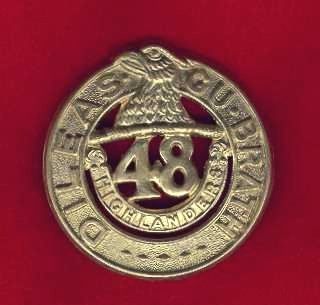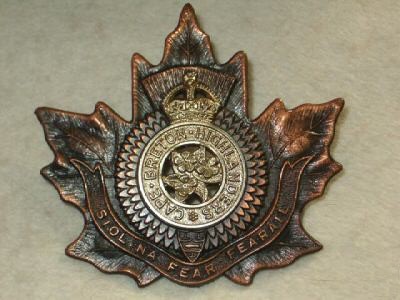
48th Canadian Higlanders
Cap Badge
| CusterMen MENU: | Italian Campaign | At The Front | Books | Armies | Maps | 85th Division | GI Biographies | Websites |
This page provides general details of the organization of the Canadian Army during the Italian Campaign, primarily after June 1944 until they transferred out. The intent of my website limits a full review of all the units and organization during the entire period. Hopefully, this will explain their origin and organization.British 8th Army Commanding Generals:
Gen Bernard "Monty" Montgomery commanded during Sicily and landings in Italy.
Lt.-Gen Sir Oliver Leese- 31 Dec 1943 - 1 Oct 1944.
Gen Sir Richard L. McCreery- from 1 Oct 1944 - end of war.
Desert Air Force was the British Royal Air Force command for air forces in N. Africa and Italy.
For other Nationalities, go to:
British
Canadians French Polish Brazilians
German Italian
The 1st Canadian Division was the first Canadian unit to be sent to Italy and was the first major deployment of Canadian troops in combat. By the time of the invasion of Sicily, the Canadians were getting anxious to see battle. They had been training in Britian for 2 years. The only combat that any Canadians had seen was a small contingent had participated in the failed Dieppe Raid on the coast of France. Now, the Canadian newspapers and politicians were calling for their troops to be used. One fear was that Canada would not be considered a part of the Allies, which could influence world opinion of them after the war. This long period of inactivity could cause the Canadian troops to loose their fighting ability.
At the last minute of the planning for Operation HUSKY, Churchill recommended that the Canadian troops be used in the invasion of Sicily. Eventually, the 1st Canadian Division was substituted for the 3rd British Division. The Chief of the Imperial General Staff immediately sent word of inclusion of Canadian troops in Operation HUSKY to the Allied commander in the Mediterranean Theatre.
The 1st Canadian Division and the 3rd British Division met on all levels to transfer plans on the operation. Their cooperation went so well, that the 3rd British Division and the 2nd Canadian Division were used together in the Normandy invasion.Personal from C.I.G.S. for General Eisenhower,
repeated General Alexander.1. Both political and military grounds make it essential that Canadian forces should be brought into action this year. It had been hoped to employ them in operations across the channel from U.K. but likelihood of such operations has now become extremely remote owing to recent addition to HUSKY of practically all remaining landing craft.
2. It has therefore been decided that 1 Canadian Division and a tank brigade similarly organized to 3 Division and its tank brigade will replace latter in the Eastern Task Force for the HUSKY operation subject to confirmation from Canadian Government which we hope will be immediately forthcoming.
3. I very much regret this last minute change. We have been very carefully into its implications and consider it quite practicable. The Canadian Division is in a more advanced state of combined training than 3 Division and the Canadian planning staff have already started work with full assistance of 3 Division so no time is being lost.
4. Request that Force 141 and 545 be informed.
Canadian 1st Division
Order of Battle
Battle of Ortona
December 1943The 1st Division consisted of three infantry brigades and an armoured brigade and totaled 18,347 men at full strength. The Division was equipped with 12,265 pistols and rifles, 1,302 machine guns, 359 mortars, 436 PIATs (Anti-Tank projectile), 307 artillery guns, and 3,347 vehicles.
The Armoured Brigade had roughly 5,000 men. Each Armoured Regiment had 60 Sherman (M4A4) tanks.
1st Infantry Brigade 2nd Infantry Brigade 3rd Infantry Brigade The Royal Canadian Regiment
The Hastings and Prince
Edward Regiment
48th Highlanders of CanadaPrincess Patricia's Canadian
Light Infantry
The Seaforth Highlanders of
Canada
The Loyal Edmonton RegimentRoyal 22e Regiment
The Carleton and York
Regiment
The West Nova Scotia
Regiment1st Armoured Brigade
11th Armoured (Ontario) Regiment
12th Armoured (Three Rivers) Regiment
14th Armoured (The Calgary) RegimentOther Units
4th Princess Louise Dragoon Guards Regiment
The Saskatoon InfantrySupport Units
5 Regiments of Artillery
4 companies of Engineers
3 Field AmbulancesThe Battle of Ortona was fought to capture the port city on the eastern coast during the cold, wet conditions of December 1943. The British plan was to capture this port and advance north and then turn west to cross the mountains behind the German defenses at Cassino. The town was defended by the German 1st Parachute Division. The progress of the battle was well-publicized and Hitler personnaly gave the order to defend it at all costs.
The victory was a costly one: the Loyal Edmonton Regiment had 172 casualties, including 63 killed; the Seaforth Highlanders 103, including 41 killed. The total number of Allied casualties reached 650 officers and men of all ranks.
Source: the Juno Beach Centre website.The Canadians continued to serve in the Italian Campaign under the command of the British 8th Army until February 1945, when it was sent to Germany.
The Moro River Canadian War Cemetery lies in the locality of San Donato in the Commune of Ortona, Province of Chieti, and is sited on high ground near the sea just east of the main Adriatic coast road (SS16). Moro River Canadian War Cemetery contains 1,615 Commonwealth burials of the Second World War.
 48th Canadian Higlanders Cap Badge This regiment fought
in many battles as part of the British 8th Army. At Ortona, this
regiment
advanced north of the town to cut off the German supply routes. For three days they
were
isolated, yet held off all counter-attacks.
|
Canadian Regiments that served in Italy
LISTED ALPHABETICALLY BY NAME SEE LEGEND BELOW
Unit Name & alternate name Command Remarks Regulars
Princes Particia’s Canadian Light Infantry
2nd Bge, 1 ID
OrtonaRoyal 22e Regiment (“Van-Doos”) 3rd Inf Bge, 1 ID Ortona Royal Canadian Dragoons
(1st Armored Car Regt)I Corps Lord Strathcona’s Horse
(2nd Armored Regt)5 Armd Bge, 5AD Ortona -------------------------- British Columbia Dragoons
(9th Armored Regt)5 Armd Bge, 5AD Calgary Regt (14th Armoured Regt) 1 Armd Bge, 5AD Ortona Cape Breton Highlanders 11 Inf Bge, 5AD Carlton and York 3 Inf Bge, 1 ID 8th Princess Louise North Brunswick Hussars (5th Arm Rgt) 5 Armd Bge, 5AD Elgin Regiment
I Canadian Corps one sqd 1st Cdn Tank Delivery Sqd First Special Service Forces
(2nd Cdn Parachute Btn)5th Army Served at Anzio. 4th Princess Louise Dragoon Guards
(4th Recce Regt)1 ID & 5AD 48th Highlanders of Canada 1 Inf Bge, 1 ID Ortona Gov. General’s Horse Guards
(3rd Armd Recce Regt)5AD
Hastings & Prince Edwards Regt 1 Inf Bge, 1 ID
Irish Regt of Canada 11 Inf Bge, 5AD
Lanark & Renfrow Scottish Regiment
(1st Light AA Regt)
(later L&R Scottish) Lorne Scotts - base depot detachment in Italy Loyal Edmonton Regt 2 Armd Bge, 1 ID Perth Regiment (Motor) 11 Inf Bge, 5AD
Princess Louise Fusiliers (Motor) 11 Inf Bge, 5AD
Saskatoon Light Infantry (MG Btn) 1 ID
Seaforth Highlanders of Canada 2 Inf Bge, 1 ID
Three Rivers Regiment
(12th Armored Regt)1 Armd Bge
West Nova Scotia Regiment
3 Inf Bge, 1 ID
Westminster Regiment (Motor) 5 Armd Bge, 5AD
LEGEND: 1 ID = 1st Canadian Infantry Division 5AD = 5th Canadian Armoured Division
Bge = Brigade
 Cape
Breton Higlanders
Cap Badge
Cape Breton Highlanders landed in Italy on November 10, 1943, as part of the 11th Infantry Brigade, 5th Armored Division. The unit's first task was to relieve the West Nova Scotia Regiment at Ortona. They were used in the assault on the GOTHIC Line near Montecchio. |
Zuehlke, Mark; "Gothic Line; Canada's Month of Hell in WW2 Italy", Douglas
& McIntyre, 2003.
Chartrand, Rene; "Canadian Forces in WW2", Osprey publications 2001.
Go To:
US Units
Canadians French Polish Brazilians
German
.
| CusterMen MENU: | Italian Campaign | At The Front | Books | Armies | Maps | 85th Division | GI Biographies | Websites |